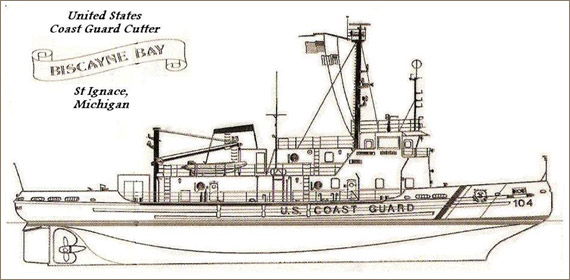Cutter Biscayne Bay
Mission and History
Homeported in St Ignace, Michigan since her commissioning on December 8, 1979, the cutter BISCAYNE BAY is the fourth vessel of the Coast Guard’s 140 ft. “Bay” class. This class of icebreaking harbor tug was designed to replace an aging fleet of 110 ft. harbor tugs and to meet the Coast Guard’s domestic icebreaking responsibilities well into the next century.

Built in Tacoma, Washington by Tacoma Boatbuilding, BISCAYNE BAY’s primary mission is maintaining tracks in the connecting waterways in the Great Lakes and assisting vessels through the icebound shipping lanes of the Great Lakes. Her primary areas of operation are the Straits of Mackinac and the St. Mary’s River. The cutter also frequently operates in the St. Clair/Detroit River system, Green Bay, Duluth, Minnesota, and Thunder Bay, Ontario.
Because of the need for larger and stronger icebreakers, BISCAYNE BAY was designed with many new innovations aimed at increasing her icebreaking capabilities. This vessel has greater horsepower, displacement, and a wider beam than the older icebreaking tugs it replaced. In addition, she is equipped with a hull air lubrication system, commonly referred to as a “bubbler” system. The bubbler forces large quantities of low pressure air through ports along both sides of the cutter’s hull. The air then rises to the surface, causing an upward flow of water, which acts as a lubricant between the hull and the ice. This greatly reduces the friction caused by the contact of ice and snow on the cutter’s hull, thus making it possible to go through a given thickness of ice using less horsepower.
There are other improvements included in this vessel’s design: greater speed enables BISCAYNE BAY to reach operational areas sooner, an increased fuel capacity gives this vessel twice as much cruising range as the older icebreaking tugs, and the capability of remaining underway for 7 days make her ideally suited to support the broad range of other missions she is assigned to in the Great Lakes. The cutter’s other missions include Search and Rescue, Maritime Law Enforcement, Port, Waterways, and Coastal Waterways Security, Public Affairs, Marine Environmental Protection, and Homeland Security.
The designed capabilities of the BISCAYNE BAY coupled with the “optimally manned” crewing concept, results in the most economical, yet efficient, resource to serve the public.
